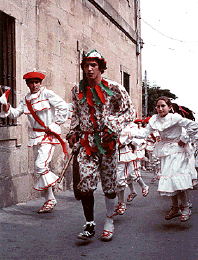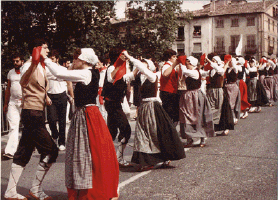| DIVERSITY IN TRADITIONAL DANCE STYLES |
 |
The systematisation of the Basque folk dance corpus is a complex task, focusing on festivals, physical context and choreography.
We can find complete dance cycles from specific areas together with certain dances common throughout an entire province or only in certain towns.
| DANTZARI DANTZA FROM DURANGALDEA (BIZKAIA) |
 |
 |
Without question, the best known cycle of dances, both within and beyond the borders of the Basque Country-for a variety of reasons-is the Dantzari Dantza or Jantzari Jantza. It is danced annually and with great ritual by a number of dance groups throughout all of the Basque provinces and at different parish churches in the Duranguesado area, where it is originally from.
On the eve of the local feast day, it is the custom to set up the traditional San Juan or Donianeatxa oak tree (nowadays usually a poplar). The trunk is peeled and the branches limbed, and flowers and a sometime a flag or two are placed at the top. All of the festive activities take place around this symbol, which is set up in the middle of the town square.
The nine dances that make up the cycle have remained unchanged since at least the 19th century; the choreography consists of two parallel rows of dancers standing face to face. The dancers, in a show of virility, very skilfully manoeuvre fighting weapons as part of the dance.
The names of some of the dances correspond to the number of dantzaris (performers) who display their skill at the central moment of the exhibition: Banangoa, Binangoa, Launangoa (one, two, four); others take on the names of the tools, or weapons that are used bang against one another: Ezpata Joku txikia or nagusia (sets of small or large swords), Makil Jokua or Makil Dantza (sticks); the rest, Agintariena, Zortzinangoa and, finally, Txontxongiloa, where one dancer is lifted in a horizontal position while the others file underneath the body. According to different legends this act represents the execution of a bandit or the exaltation of a leader.
Another cycle of similar dances can be seen in the Brokel Dantza from Gipuzkoa, which also comprises nine dances and small and large sticks banged against each other. In the Zinta Dantza shields are also used. We also find similar characteristics in the cycles of dances from the towns of Berastegi and Lizartza, danced for the feast day of San Juan and during Carnival.
| SORGIN DANTZA FROM ORIA (GIPUZKOA) |
 |
 |
The comical or burlesque dances reach their peak in the Sorgin Dantza, or dance of the witches. These dances, a combination of wild and sometimes a bit obscene body movements, have managed to remain alive over time in certain towns.
The best known of these dances can be seen in the town of Lasarte-Oria. As the story goes, this dance simulates a group of workers who moved here from the town of Bergara.
Today this dance is also danced in the town of Antzuola during Carnival, although here, along with the dantzaris and musicians, there are also people dressed up as bears and monkeys. And the neighbouring town of Aretxabaleta has an identical version known as Txino Dantza. The dancers wear a simple linen nightgown and sing a song in allusion to green grapes.
It appears that dances of this type were more common in the past. In Otxandio the elders vaguely recall an itinerant Sorgin Iantza which was very theatrical and involved a lot of shouting.
| FOLKLORE FROM THE BAZTAN VALLEY (NAFARROA) |
 |
 |
Very few places have such a rich cultural tradition as can be found in this unique verdant valley with its clean air and cool water.
Cencerradas, or children's cowbell dances in early January; Sagar Dantza (apple dance) at Carnival time, complete with bear; in May, songs for collecting money; and on the patron saint feast day, the Mutil Dantzak (boy's dances), a deeply rooted local tradition.
In the town square, the participants tip their txapelas (Basque beret) and shout "aunitz urtez!" (for many years). They form a circle and rhythmically move in a counter clockwise direction. The dance steps carry names that have very little to do with their movements: Xerri-begi (swine's eye), Xoxuaine (thrush), Xoriaine (bird) or Ardoaine (wine), Zazpi Jautzi (seven jumps), Hiru puntukoa (three points)...
All along the Basque Pyrenees there are countless similarities. The northern regions are not only like in terms of topography but also language and, of course, choreography. Jautziak (jumping dances) are circle dances common to a number of towns, and having names that refer to the towns or areas themselves: Azkaindarrak, Milafrangarrak, Lapurtarrak…. And here we should not overlook one of the most important centres where these and other dances have been kept alive-the border town of Luzaide. Here the ancestral Carnival celebration, changed from Easter Sunday over 50 years ago, is highlighted in the performance of the Bolantak dances, with long ribbons dangling from the backs of the dancers' shirts. The entire town and surrounding villages take part in this celebration, with colourful costumes, festive environment and throngs of people.
Back to the Baztan Valley, we find another dance cycle. The Irri Dantzak or Iostaketa Dantzak, or dance-games. Originally these dances were enjoyed when taking a break from working in the fields, or as a way of entertainment during long winter days. Their names are connected with how they are danced/played: Katadera Dantza (chair dance(s)), Esku Dantza (hand dance(s)), Saskito Dantza ("almud"-a grain measurement-dance), Zurrume Dantza (heel dance) or Zartain Dantza (Frying pan dance), among others.
| MASKARADAK FROM ZUBEROA |
 |
 |
Carnival representation and farce is seen at its best at the winter masquerades in the Zuberoa area. Itinerant dances are mixed with games, gags, curious dress, tattered clothing, money collection, popular participation, exhibition, mock trades and marginal races, varied satirical languages and music.
Every year the townspeople, sometimes bolstered by out-of-towners, put together and rehearse a complete repertory to be put on each Sunday for approximately four months, in a different town in the valley.
The entourage is divided into two practically antagonistic groups. The "reds", or Gorriak, are elegantly dressed, orderly and move with great grace. The "blacks", or Beltzak, are disorderly and rude, dress in rags, get in the way of passers-by, shout and formerly would speak in the Bearn dialect or Occitan.
In the morning these groups walk around the town, wined and dined by their hosts. All the while the Barrikadak are taking place, a blend of money collection and peaceful dance confrontation, after which the participants are given, sweet and salty snacks, refreshments and liquors..
Dances are taken in turns, featuring the most important characters Txerrero, Gathuzain, Zamaltzain, Kantiniertsa and Banderari, gravitating between muriskas and antrixat before the expectant eyes of Jauna and Anderea (lord and lady). Meanwhile, the Negros, Caldereros and Gypsies flounce upon one another, joke playfully and harass, both verbally and physically, the rest of the entourage and the public, bringing about fun and laughter.
| FOLKLORE OF THE SOUTH |
 |
 |
With a contrast in geography and climate, the Mediterranean offers us an additional varied element in its festive celebrations.
First off, the Rioja Alavesa, is closely tied to other nearby towns. In its patron saint feast days, between spring and summer, at the height of the holiday season, is when the processions and rituals come together.

Photo: Procession of dancers from Biasteri/Laguardia (Araba)
In Iekora, on the feast day of Santo Domingo, a dance known as the Dance of the Virgen de la Bercijana or the Virgen de la Cadena, is performed in front of the image and of the Virgin and along the route between churches. In Biazteri, on the feast day of San Juan, the local flag is waved, accompanied by the Danza de los Ramos. In Eltziego, during the Virgen de la Plaza festivities in September, El Árbol, Cuatrocalles and the Jota. And in Oion, in the middle of winter, the Danza de los Patronos and the unique Revolcón del Cachi. This tradition consists in waving the municipal flag, below which the so-called Cachi, dressed in a Harlequin-like costume, rolls about on the ground.
In most of the dances from this area this character appears dressed in jester-like clothing, and has names such as Cachimorro, Cachirulo and Cachibobo and/or the Bastonero. This character is in charge of leading the parade or of entertaining the crowds, depending on the town.
The Erribera region in Navarra is influenced by other nearby towns. In places such as Kortes, Fustiñana, Ablitas, Monteagudo, Murtxante, Ribaforada or Buñuel, the Dance or Paloteado, is a combination of theatre in verse and dance, with historical relevance and certain reminders of medieval its origins: El Rabadán, el Mayoral... and dances with bows, ribbons and sticks.
| SOKA DANTZAK |
 |
This section includes a large group of dances all having one thing in common. The Soka Dantzak or rope dances can be found throughout the Basque Country. They have a number of different names, including Aurreskua, Erregelak, Ingurutxoa, Zortzikoa, Soka Dantza, Baile de la Era or Larrain Dantza, Ttun ttun, Dantza or Iantza Luze, Branlea, Trapatan, Pamperruque, etc.

Photo: The dancers of Lizarra/Estella (Navarre) dancing in the procession on the most important day of the festivities in honour of the local patron saint.
These are social dances par excellence. Both sexes take an active role, breaking with the traditional male hegemony. There is no set criteria for dress as is often the case in other types of dances.
These dances are made up of different parts, some of which are performed on their own. Such is the case of dances a lo suelto (individual) or a lo agarrao (dances where the couple holds each other close together) dances: Jotas, Arin-arin or Porrusaldak/and the so-called Kalejirak dances.
Structure varies from one dance to another, both in order and number, but they all have a common denominator: the categorisation and sense of human relationship.
The challenge between the first and the last hand, that is the first and last one on the rope. the individual display of each participant, the invitation to the opposite sex to be "honoured" or revered, both individually and collectively, and finally everyone dancing the Jota, Arin-arin and Biribilketa as they leave the town square. In other varieties, the women have an active role from the outset, or even lead the dance.
There was a time when Soka Dantzak permeated every corner of the country. Today they have been replaced by the so-called "Aurresku of honour", which are the much the same as far as melody is concerned, but totally different since they are now an individual dances lacking any of the original character.
Emilio Javier Dueñas
|